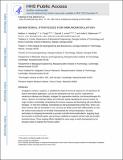| dc.contributor.author | Hotaling, Nathan A. | |
| dc.contributor.author | Babensee, Julia E. | |
| dc.contributor.author | Tang, Li | |
| dc.contributor.author | Irvine, Darrell J | |
| dc.date.accessioned | 2017-04-13T18:35:10Z | |
| dc.date.available | 2017-04-13T18:35:10Z | |
| dc.date.issued | 2015-12 | |
| dc.date.submitted | 2015-09 | |
| dc.identifier.issn | 1523-9829 | |
| dc.identifier.issn | 1545-4274 | |
| dc.identifier.uri | http://hdl.handle.net/1721.1/108131 | |
| dc.description.abstract | Strategies to enhance, suppress, or qualitatively shape the immune response are of importance for diverse biomedical applications, such as the development of new vaccines, treatments for autoimmune diseases and allergies, strategies for regenerative medicine, and immunotherapies for cancer. However, the intricate cellular and molecular signals regulating the immune system are major hurdles to predictably manipulating the immune response and developing safe and effective therapies. To meet this challenge, biomaterials are being developed that control how, where, and when immune cells are stimulated in vivo, and that can finely control their differentiation in vitro. We review recent advances in the field of biomaterials for immunomodulation, focusing particularly on designing biomaterials to provide controlled immunostimulation, targeting drugs and vaccines to lymphoid organs, and serving as scaffolds to organize immune cells and emulate lymphoid tissues. These ongoing efforts highlight the many ways in which biomaterials can be brought to bear to engineer the immune system. | en_US |
| dc.description.sponsorship | Bill & Melinda Gates Foundation | en_US |
| dc.description.sponsorship | United States. Army Research Office. Institute for Soldier Nanotechnologies (Contract W911NF-13-D-0001) | en_US |
| dc.description.sponsorship | Ragon Institute of MGH, MIT and Harvard | en_US |
| dc.description.sponsorship | Cancer Research Institute (New York, N.Y.) (Irvington Postdoctoral Fellowship) | en_US |
| dc.description.sponsorship | National Institutes of Health (U.S.) (Awards AI104715, CA172164, CA174795, and AI095109) | en_US |
| dc.language.iso | en_US | |
| dc.publisher | Annual Reviews | en_US |
| dc.relation.isversionof | http://dx.doi.org/10.1146/annurev-bioeng-071813-104814 | en_US |
| dc.rights | Creative Commons Attribution-Noncommercial-Share Alike | en_US |
| dc.rights.uri | http://creativecommons.org/licenses/by-nc-sa/4.0/ | en_US |
| dc.source | PMC | en_US |
| dc.title | Biomaterial Strategies for Immunomodulation | en_US |
| dc.type | Article | en_US |
| dc.identifier.citation | Hotaling, Nathan A., Li Tang, Darrell J. Irvine, and Julia E. Babensee. “Biomaterial Strategies for Immunomodulation.” Annual Review of Biomedical Engineering 17, no. 1 (December 7, 2015): 317–349. | en_US |
| dc.contributor.department | Massachusetts Institute of Technology. Department of Biological Engineering | en_US |
| dc.contributor.department | Massachusetts Institute of Technology. Department of Mechanical Engineering | en_US |
| dc.contributor.department | Koch Institute for Integrative Cancer Research at MIT | en_US |
| dc.contributor.mitauthor | Tang, Li | |
| dc.contributor.mitauthor | Irvine, Darrell J | |
| dc.relation.journal | Annual Review of Biomedical Engineering | en_US |
| dc.eprint.version | Author's final manuscript | en_US |
| dc.type.uri | http://purl.org/eprint/type/JournalArticle | en_US |
| eprint.status | http://purl.org/eprint/status/PeerReviewed | en_US |
| dspace.orderedauthors | Hotaling, Nathan A.; Tang, Li; Irvine, Darrell J.; Babensee, Julia E. | en_US |
| dspace.embargo.terms | N | en_US |
| dc.identifier.orcid | https://orcid.org/0000-0002-4244-5978 | |
| mit.license | OPEN_ACCESS_POLICY | en_US |
